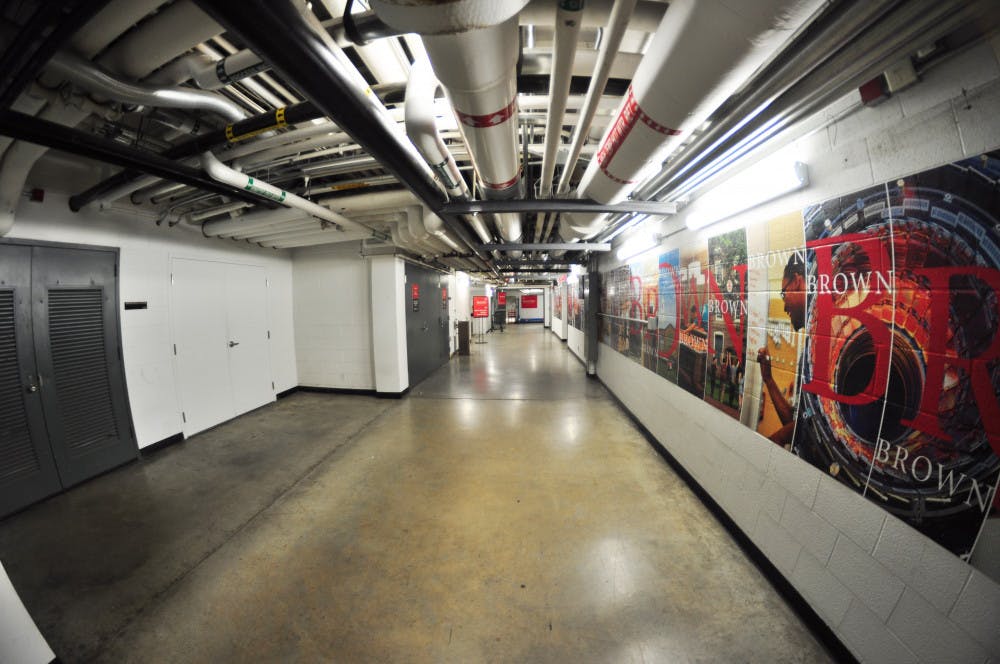From the use of fume hoods to the multiple trainings that students must attend to work in a lab, safety precautions and protocols are emphasized across University research laboratories. Safety regulation and building upkeep are monitored in tandem by departmental safety committees, the Department of Environmental Health and Safety and the Department of Facilities Management, said Alfred Tente, electronics technician and member of the Department of Chemistry’s safety committee.
Stringent laboratory inspections and trainings
About 300 labs are inspected by EHS staff at least once per year, wrote Stephen Morin, director of EHS, in an email to The Herald. Any violations discovered are reported to the lab supervisor and the department chair, who are responsible for resolving the issues, Morin added. After responding to the problems, the lab supervisor must notify EHS, who will then visit the lab again to ensure that the issues have been corrected, Tente said.
Before entering the lab, all researchers are trained in general laboratory safety — including chemical handling, electrical safety and emergency response — and hazardous waste management, Morin wrote. Depending on their focus, researchers may also be trained to work with biological or radioactive materials, he added.
Departmental safety committees are overseen by the University’s Laboratory Safety Committee, which meets every quarter to discuss incidents, new safety criteria and possible plans for action, said William Patterson, senior research engineer and chair of the committee. Committee members include faculty members from various departments and representatives from EHS, facilities management and the Office of the Vice President for Research, according to meeting minutes from June 22.
Dangerous incidents in the lab
Examples of incidents discussed during the meeting include a broken mercury thermometer and a researcher fainting from working with chemicals, according to the minutes.
Other incidents may not be issues, upon further investigation. “A chemical odor was reported in a lab. Turned out not to be a chemical odor after all,” the minutes read.
The committee also discusses major incidents at other universities and ways to prevent anything similar from happening in University labs, Patterson said. In 2011, a Yale physics student was working alone after hours in a machine shop and died after her hair — which was not tied up — was caught in a machine, pulling her head toward it and cracking it.
The University Lab Safety Committee obtained reports from Yale and developed further precautions, Patterson said. Patterson personally wrote the code for the card access system to the University student machine shop, which now requires two cards to access. The protocol aims to ensure that at least two people enter the shop together, he said. A security camera was installed at the entrance, and personal dress guidelines were emphasized in trainings, he added.
None of those interviewed recall any recent major safety incidents at the University. Patterson said the only fatal accident he remembers occurred around 1967 when a biology student was studying the effects of electrical fields on bacterial growth and was electrocuted to death after forgetting that the power supply was still on and opening the tank of bacteria.
Twenty years ago, in Patterson’s own lab, a graduate student did not immediately wash his finger after coming into direct contact with hydrofluoric acid, which initially does not hurt but reacts with calcium to cause severe damage to tissue and bone. The student’s finger had to be amputated, Patterson said.
Dean Hudek, laboratory physicist and member of the safety committee, recalls an explosion in his lab about 25 years ago that occurred when a student accidentally created a bomb following “a series of unusual events.”
Safety regulations and infrastructure
Though some of the buildings may need renovations, infrastructure problems are only inconveniences and do not affect safety, Tente said.
For example, certain floors of Barus and Holley were flooded in 2012 and 2013 due to improper connections to the cooling system, Patterson said. Barus and Holley also experienced several power outages over the summer, he added.
Tente, who acts as the unofficial building superintendent of the GeoChem building, said that it vibrates because it sits over some mechanical systems and that there are some ventilation issues. These issues only affect research because of how machines register the vibrations, but they pose no threat to safety, Tente added.
The timing of repairs depends on the equipment. Some sensitive equipment are on a regular repair schedule, while other aspects of the infrastructure are only replaced when they malfunction, Patterson said. Equipment replacement may also depend on whether funding is available, Tente said.
Safety regulations are created by a combination of private and public entities, Patterson said. For example, some of the most recent changes to Barus and Holley have been the installation of ground fault interrupters — circuit breakers designed to shut off power to prevent electrical shock — to several labs, he said. These interrupters are now required for outlets within 10 feet of plumbing, due to a regulation outlined in the National Electrical Code. This regulation was approved by the American National Standards Institute — a nonprofit given authority by the state.
Machine shop regulations come from the Occupational Safety and Health Administration, while hazardous waste regulations come from the Environmental Protection Agency and the Rhode Island Department of Environmental Management, Patterson added. Changes in regulation are monitored by EHS, Hudek said.
With the rise of more stringent and detailed regulations, the safety committee tries to find ways to balance safety and practicality, Hudek said. If safety procedures are too tedious or “cumbersome,” people are likely to either ignore them or create additional problems when trying to follow them.
The lack of incidents at the University shows that “Brown is very dedicated to safety,” Hudek said.
“We just want (people) to concentrate on their research and studies and not have to worry about (getting injured),” Tente said. “Everybody takes safety seriously. It’s a system the University has that seems to work well.”





